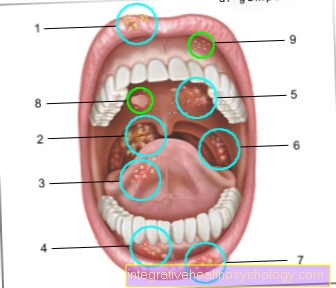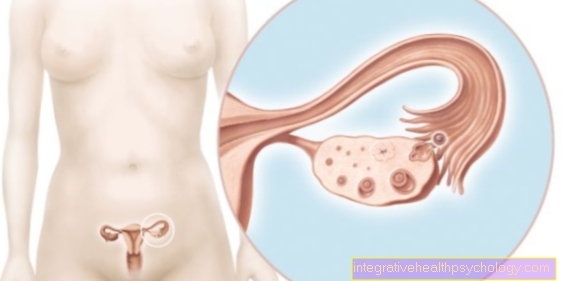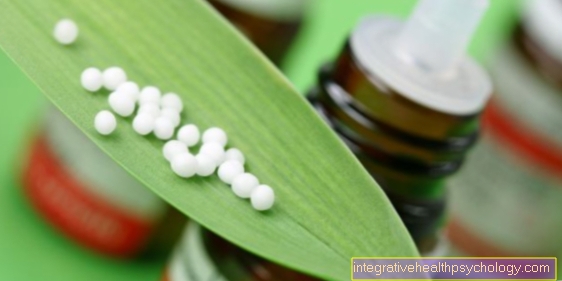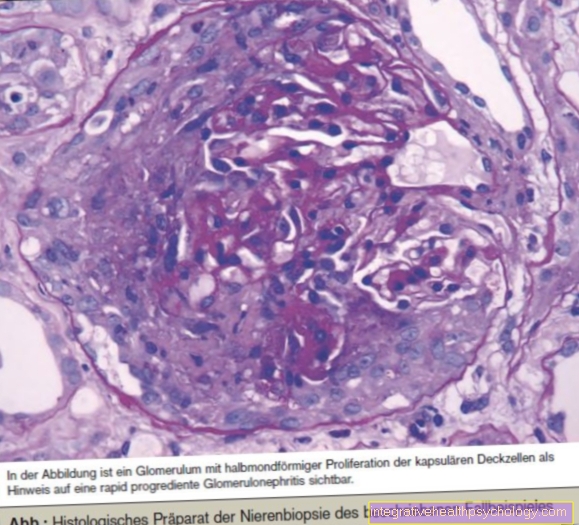Aphthae - you should know that
introduction
Various diseases can manifest themselves on the oral mucosa and tongues. In addition to injuries caused by toothbrush bristles that are too hard, it is primarily bacterial infections on the surface of the mucous membrane that lead to pathological changes. One of them are the aforementioned canker sores in the mouth. These are painful small wounds in the mouth and throat.
Also read: Changes in the mucous membrane of the mouth

What are canker sores?
Aphthae are small, rounded erosions of the mucous membrane (Mucosal injuries) preferably on the cheek mucosa, but they can also appear on the gums or tongue. The defects that look like ulcers show a whitish or yellowish surface with a crimson border. This typical appearance makes diagnosis easy.
Aphthae in the mouth are extremely painful, especially on the presence of acidic foods and drinks. They occur either individually or in groups, then one speaks of one Aphthous stomatitis.
Read more on the topic: Aphthous stomatitis
Unfortunately, they can appear again and again. The exact cause of canker sores has not yet been clarified. However, it is assumed that there can be a lifelong predisposition to the formation of canker sores. Inheritance for canker sores cannot be ruled out.
In and of themselves, mouth ulcers are harmless and will go away on their own after 1 to 2 weeks. The severe pain, which is particularly annoying with meals and speaking, is unpleasant.
Are there different types of mouth ulcers?
There are basically two types of canker sores, the so-called
- Major form:
Major canker sores (large canker sores) exceed one centimeter in diameter. The healing time of large canker sores usually takes several weeks to months. Since this type of mucosal injury is usually extremely painful, food intake is significantly influenced by the disease.
- Minor form:
Minor canker sores are small sacs of the mucous membrane that do not exceed one centimeter in diameter. Small canker sores heal within a week without any consequential damage.
In general, large canker sores take several weeks to months to heal until the damage to the mucous membrane has completely receded. The pain intensity of such a mucosal blister does not necessarily correlate with the size, because it is not the diameter but rather the exact location of the canker sores that is decisive for the impairment of the patient.
In areas of the oral cavity that are subject to high mechanical loads (for example the inside of the lip or tongue), canker sores are perceived by patients as particularly painful and bothersome.
Those affected often report that they have during the
- Speaking
- Ingestion of food severe pain
- Swallowing saliva or water
have corresponding pain.
Illustration of canker sores

The most common areas
(blue circles)
- Herpes -
Herpes simplex - Oral mucosa -
Tunica mucosa oris - Tongue -
Lingua - Gums -
Gingiva - Palate -
Palatum - Palatine almond -
Palatine tonsil - Lip -
Labium oris
Examples of large and small canker sores -
(green circles) - Large canker sores - Major form
- Small canker sores - Minor form
You can find an overview of all Dr-Gumpert images at: medical illustrations
Symptoms of canker sores
Aphthae express themselves primarily through their typical appearance.
Often canker sores are described as blisters, but this does not correspond to reality. With vesicles it is a question of a protrusion filled with liquid to the outside, while on closer inspection canker sores appear as flat mucosal defects (i.e. flat holes), as if the uppermost cell layers are missing.
At the beginning there are rather small yellowish spots with a slightly reddened edge. This is because fibrin builds up in the wound. Over time, however, a clearly recognizable bulge develops that appears whitish or yellow. However, the surrounding tissue is normal. Only rarely do groups of multiple canker sores form in one place.
The affected person suffers from severe pain, which occurs especially when the canker sore comes into contact with something, such as when eating or speaking normally, in which the wound can come to a tooth or another part of the mouth touches, occurs.
The pain is very sharp or burning. It is also often much larger than the area in the mouth suggests, so that not only does the affected tissue appear to be sore, but a much larger area.
Read more about this at: Burning in the mouth
If canker sores appear on the tongue or in the throat, i.e. in places that are subject to greater mechanical stress, the disease turns out to be even more unpleasant, as they constantly convey pain when swallowing, when coming into contact with saliva or when speaking. The pain sensation is strongest in the first few days. It feels like stitches on your tongue or like you've burned your tongue.
They are usually never noticeable externally, unless someone looks the person concerned directly into the mouth.
The pain caused by canker sores
Most of those affected describe canker sores in the oral cavity as a torment that brings severe pain and restrictions in everyday life.
Initially, a canker sore only manifests itself as redness and swelling in the mouth or the oral mucosa. The affected areas of the mucous membrane begin to tingle and burn relatively quickly. In shortest time (usually a few hours after the first symptoms appear) The pain develops tremendously and becomes even worse when you speak and eat.
Where do canker sores occur?
Canker sores can basically develop on any surface of the mucous membrane in the body. This is extremely painful damage to the mucous membrane, which is surrounded by an inflamed border and can be seen with the naked eye as small whitish-yellow mucous membrane wounds.
Most canker sores show up in the following areas:
- Oral mucosa
- Gums
- tongue
- palate
- Almonds
- and canker sores are not uncommon even in the genital area.
Canker sores on the tongue
The affected patients feel that their quality of life is sometimes severely restricted due to the pain that canker sores that develop on and / or under the tongue. The formation of canker sores in this form is usually triggered as part of a herpes simplex infection (so-called mouth rot, (Latin aphthous stomatitis) and is characterized by frequent recurrence after a single subsidence.
Read more on the topic: Mouth rot
Especially stressful situations, inner restlessness or feelings of disgust can provoke the reappearance of canker sores in the tongue. In most cases, canker sores of the tongue become the so-called "minor form" (small canker sores) whose size does not exceed a diameter of approximately one centimeter are counted. Small canker sores usually heal within one to two weeks.
In rare cases, however, the size of canker sores in the area of the tongue, palate or lips can exceed a diameter of one centimeter, in such cases one speaks of a "major form" in medical terminology (Big canker sores).
Small children and infants in particular stop eating and drinking when they have canker sores on or under the tongue.
In addition to eating, speaking, touching the mucous membrane region, swallowing water and saliva can also be extremely painful.
The pain felt by the respective patient is in no way dependent on the size of the canker sores, rather the location of the mucosal injury plays a decisive role in influencing the patient concerned. For this reason, a single small canker sore with a diameter of only half a centimeter in the area of the tip of the tongue can be perceived as much more painful than a large canker sore (diameter greater than one centimeter) that occurs on the cheek mucosa. This fact shows that canker sores, which are located in the area of mechanically stressed mucous membranes, cause pain particularly often.
Read more on the subject at: Canker sores on the tongue
Exactly which food or food components cause irritation of canker sores on the tongue seems to be different for every person. Mostly, however, foods seem like
- fruit
- lemonade
- cola
- nuts
- Sweets (chocolate)
- raw tomatoes
to play a crucial role.
Aphthae on the lip
The occurrence of inflammatory injuries to the mucous membrane in the form of canker sores on the lip can also be perceived as particularly annoying by the affected patients. Similar to canker sores on and under the tongue, it seems likely that canker sores on the lip can be triggered by the herpes simplex virus.
If these injuries to the mucous membrane occur on the outside of the lip, those affected usually feel only slight to moderate pain. Since canker sores on the outside of the lip can become very large in many cases, patients are particularly disturbed by them with regard to aesthetics.
Particularly painful canker sores of the lip are mostly located on the mechanically highly stressed inside.
Canker sores on the gums
The degree of pain caused by canker sores on the gums can also be intensified during daily oral hygiene. Touching the affected areas of the mucous membrane with the toothbrush, dental floss and / or interdental brushes can cause irritation of the mucous membrane defect.
In principle, canker sores can appear on all mucous membranes, including the gum area. In most cases they appear on the gums as small, rounded erosions with a white or yellow coating. Aphthae of the gums can be particularly painful and cause severe burning in the affected patient.
A connection between the frequent occurrence of canker sores of the gums and inflammation of the gums (gingivitis) has not been clearly established. This is due to the fact that gum inflammation is usually triggered by poor oral hygiene and food residues that settle in the area of the gum line.
Read more on the topic: Inflammation of the gums
The causes of a canker sore in the gums, on the other hand, have not been clearly clarified, but several factors are assumed to be interrelated.
- With a weakened immune system, e.g. with a cold or periods of increased stress
- It is now assumed that local gum injuries (for example through mechanical stimuli such as brushing teeth that are too firm) can be provoked.
- In addition, people who have severe nutritional deficiencies or deficiencies in vitamin B12, iron or folic acid seem to develop canker sores on the gums significantly more often.
- It has also been found that smokers generally suffer from canker sores less often than non-smokers. People who smoke regularly develop canker sores on the gums, especially when they are not nicotine.
In general, it cannot be assumed that the gums are particularly at risk from an ulcer. In most cases, wounds in the gingiva area also heal completely by themselves without the inflammatory processes spreading to the neighboring gums or jawbone.
While there is a canker sore on the gums, the affected patient should be particularly careful with their daily oral hygiene and exert as little pressure as possible on the mucous membrane vesicle. An opened mucosal vesicle is usually much more sensitive to certain stimuli and causes significantly more pain.
Aphthae in the throat
In addition to the mouth and tongue, canker sores can also occur in the area of the throat and the palatine tonsil (“tonsils”). However, they are a little less common there. It is small (0.5mm) oval inflammations that usually occur where the oral mucosa is not directly connected to the underlying bone.
Read more on the topic: Aphthae in the throat
Aphthae can occur once, but in most people they occur repeatedly and cause unpleasant pain. Usually it hurts more if the affected area is mechanically used more often. It is more uncomfortable on the tongue than on the cheek.
Aphthae in the throat belong to this category because, due to their location, they come into contact with food or saliva with every swallowing process, when drinking and eating and thus cause increased pain. Even the most deliciously prepared food can become torture. The pain is usually burning and radiates over a larger area than the size of the canker sores.
The cause for the development of canker sores in the pharynx, as with their other possible origins in the oral cavity, can be traced back to many causes and also not yet fully clarified. They can be genetically predisposed, a result of a previous injury or a deficiency in vitamin B12, iron and / or folic acid. Stress or the ingestion of very acidic foods (fruit) can also lead to canker sores in the throat area. The development process of canker sores is usually hidden from those affected until the first pain occurs when swallowing or even when speaking.
From then on it becomes uncomfortable until healing, which can take up to two weeks. The pain is worst in the initial phase, but gradually subsides over time. In the case of canker sores in the throat area, in addition to problems with swallowing, there is another problem with treatment, including with home remedies. They are very far back and are therefore difficult to reach and find.
Furthermore, the touch is very uncomfortable because the gag reflex is triggered immediately. So it turns out to be difficult to apply a gel, an ointment or a cotton swab soaked with chamomile tea to the affected area. It takes a lot of patience, caution and calm.
What is the cause of canker sores?
The causes of canker sores are still largely unexplained, but it is clear which factors promote the formation of such a pathological process within the oral cavity.
- Virus infection
- Indigestion
- decreased resistance of the immune system due to general illnesses
- Combination of genetic (hereditary) factors and unfavorable eating habits
- specific injuries that lead to the formation of fibrin deposits by triggering inflammatory processes
- Deficiencies: Vitamin B12 (Cobalamin), Iron and / or folic acid (vitamin B9 or vitamin B11)
- prolonged stress and / or lack of sleep
- Colds and the resulting general immune deficiency
Aphthae are preferred in women, as well as in older people. But children can also get canker sores. Especially when the teeth are changing.
How are the canker sores treated?
Therapy is limited to the administration of agents that reduce or eliminate pain. A causal, i.e.causal treatment does not exist. The repertoire for local applications is large. It includes antiseptic solutions, pastes containing cortisone, antibiotics, or douching with hydrogen peroxide.
This variety of recommendations already shows that there is no really effective remedy. Antibiotics, of course, cannot help if it is a viral infection.
- Ointments with surface anesthetic: The most effective for treatment / therapy are ointments that contain a surface anesthetic, such as Dynexan® oral gel or Solcoseryl® acute, as they alleviate the pain or, at best, eliminate it. However, this does not result in faster healing.
- Disinfecting mouth rinses: Gargling with disinfecting mouth rinses, for example chlorhexidine, is a suitable measure for treating canker sores on the gums.
- Treatment with Cystus: a citrus plant that is said to have a good effect on canker sores in the gums. The disadvantage of this method, however, is the strongly bitter and pungent taste of the natural remedy.
- Cortisone-containing ointments: In particularly pronounced cases, it can be useful to think about the use of cortisone-containing ointments. These inhibit the inflammatory processes in the area of the irritated gums and allow the canker sores to disappear quickly.
Without specific treatment of the canker sores on the gums, they usually heal on their own within two weeks.
Read more about this at: Canker sores - Different options for treatment
Treat canker sores with home remedies
There are a number of different home remedies that can help relieve mouth pain. Gargle solutions made from chamomile can already be bought in the pharmacy ready for consumption, but you can also make them yourself. Simply cook a very strong chamomile tea for this. The solution disinfects and relieves pain.
Tea tree oil has a similar effect; it is simply dripped on after the canker sores have dried. However, it should be handled with care, as it can cause chemical burns if used over a large area and some people are allergic to it. A zinc deficiency can also lead to canker sores. It should therefore be taken at least 7-10mg daily to prevent problems.
Aloe vera gel can aid healing by dabbing it on the sore area several times a day. Rhubarb also has anti-inflammatory properties, which means that it is able to dry out the apthe sores.
Other skin products are: high percentage alcohol, myrrh, lemon balm or calendula tincture. Last but not least, good oral hygiene naturally also helps with quick healing.
Read more about this at: Aphthae - which home remedies can help?
Treat canker sores with homeopathy
The treatment of canker sores with homeopathic remedies is based on the principle of similarity. So the diseases are to be cured by means that cause symptoms in a healthy person similar to those in the sick person. A number of homeopathic remedies can be used for canker sores.
These include:
- Acidum hydrofluoricum (hydrofluoric acid)
- Acidum sulfricum (sulfuric acid)
- Ammonium chloratum (mineral salt)
- Borax (sodium borate)
- Carbo animalis (animal charcoal)
- Carbo vegitabilis (charcoal)
- Hydrastis (Canadian turmeric)
- Mercurius corrosivus (mercury chloride).
Before using these remedies, however, a consultation with a homeopath is recommended, as the remedies can show different effects depending on the patient. However, the effectiveness of these agents has not been proven by conventional medicine.
Read more on the topic: Homeopathy at Apthen
Homeopathy for canker sores
As with almost all diseases, there are also homeopathic remedies for canker sores that help with healing.
It helps against the burning mucous membrane Arsenicum album. To fight the canker sores yourself is common borax or Mercurius solubilis recommended. These substances also work against the swollen cervical lymph nodes that are associated with canker sores and swollen gums.
If the blisters occur mainly in the area of the tongue, this helps Natrum muriaticum. Nux vomica is the gold standard of homeopathic medicine when there are many small vesicles.
However, if the canker sores do not go away within one to two weeks, a doctor should be consulted to clarify the cause of the disease and to prescribe a conventional medicine to cure it.
More treatment options for canker sores
In most cases, canker sores heal on their own within two weeks, so that medication is not absolutely necessary. There is no direct remedy for the appearance of canker sores, but there are various possibilities to support the healing process. Over-the-counter or prescription-only products can be purchased in the pharmacy.
The funds can be sold as a spray, ointment, liquid, or gel. Most of these contain lidocaine, a local anesthetic that numbs the inflamed area for a short time. In consultation with the doctor, a solution of hydrogen peroxide can be used. This causes the entire oral cavity to be disinfected and all germs present are killed. However, this should not be used for too long as it has an irritating effect on the oral mucosa if used for a long time.
Some medical professionals recommend the use of minocycline or tetracycline, which suggests bacterial infection is the cause of canker sores. These drugs are prescribed by the doctor in tablet form and usually have to be dissolved in water, with which the oral cavity is then rinsed and the liquid is then spat out again. To relieve the pain and inflammation, there is an ointment with triamcinolone that can be applied to the affected area several times a day. The canker sore is now covered like a protective coat so that it no longer comes into direct contact with other substances and thus no pain occurs.
The healing process can be supported by taking vitamin B or C or zinc, so that the healing process is accelerated and the pain disappears more quickly.
Of course, there are also a number of home remedies that promote healing and are perfectly adequate in most cases. Chamomile or sage can be used well for this. Simply make a strong tea with it and rinse your mouth several times a day. It has a calming, anti-inflammatory effect and sage is primarily said to have an antibacterial effect. You can also dip a cotton swab directly into the tea and then dab the affected area with it. To relieve the pain, honey can also be mixed with a little turmeric and applied to the area.
Read more on the topic: Aphthae - different treatment options
Duration of canker sores
Initially, small yellowish vesicles form on the oral mucosa, which have a red border and are usually filled with liquid. They arise within a few days. Some of these blisters heal spontaneously, while others burst and then take a long time to heal completely. It is not possible to say exactly how long the healing process will take. A distinction is made here between smaller minor and larger major canker sores.
The smaller ones with a diameter of a few mm need about 10-14 days until they are gone again without outside help. They heal without scarring. The larger ones have a diameter of 1-3 cm. They can ulcerate and then penetrate deep into the mucous membrane. It takes several weeks to heal and often an unsightly scar is left behind.
The special form of herpetiform vesicles, i.e. vesicles that are similar to herpes vesicles, occur over the entire oral cavity. They disappear spontaneously after about two weeks. Home remedies and medications can reduce healing time and pain.
Read more on the topic: How long does it take for canker sores to go away?
prophylaxis
There is no direct method to prevent canker sores from occurring, as their development has not yet been fully clarified and many causes may be possible. However, it can be helpful to reduce the risk somewhat by following a balanced diet and consuming all the important vitamins. So you shouldn't have a vitamin B, iron or folic acid deficiency and you should also consume certain very acidic foods in moderation. This includes citrus fruits, lemonade or chocolate and nuts. These foods may or may not be related to the occurrence.
Smoking can also promote the development of canker sores. Your own immune system should always be sufficiently strengthened, as a weak immune system can lead to such a disease more easily.
Herpes, HIV or flu viruses are also seen in direct contact with the appearance of canker sores, so that adequate protection, also from a general medical point of view, should be taken to avoid becoming infected with these viruses. The stress level must also be kept low and when it comes to oral hygiene, care must be taken that the gums are not stressed too much, be it with tooth bristles that are too firm or toothpaste with strong abrasive particles. However, these are all only possible precautionary measures that can be taken, but cannot guarantee a non-occurrence.
Summary
Aphthae in the mouth are mucous membrane defects with a round shape and a whitish yellow surface with a dark red border. They occur either individually or in groups. They are harmless but very painful. There is no causal treatment / therapy. The best therapy is pastes with a local anesthetic to relieve pain. They have a high tendency to self-sanctify but can occur again and again.
More about canker sores
- How contagious are canker sores?
- What are the causes of canker sores?
- How can apthens best be treated?
- The best home remedies for canker sores
- The use of homeopathy for canker sores
- Aphthae in the throat
- Canker sores on the tongue
- Aphthae in pregnancy





























